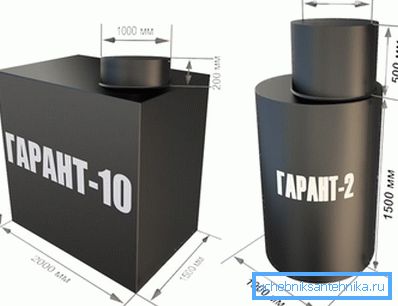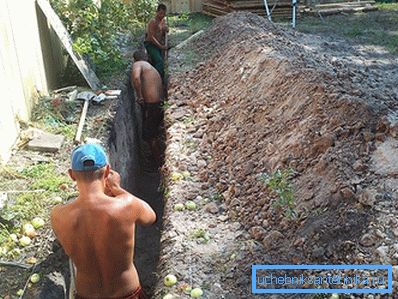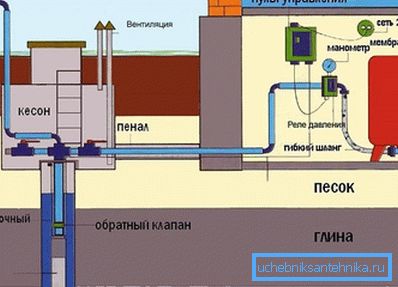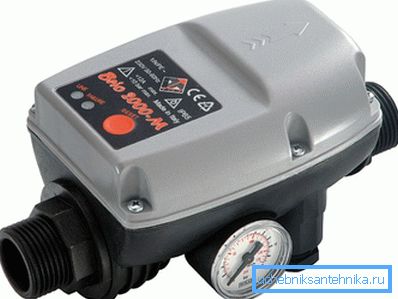Water supply of a private house from a well
A well is sometimes the only source of water for household and household needs in a country house or at a dacha. Water supply of a private house from a well is a reliable way of obtaining clean water, which can, as a rule, be used without additional purification.
Well Construction

Drilling a well with your own hands is not an easy task, but it can be done by many. We will not dwell on this in detail, so suppose that you already have a well.
If there is no well, then you first need to find water on the site, and then make a well.
Before you connect the water source to the house, you must first equip it. Under the arrangement of the well means the installation of a pump, downhole adapter or caisson and the tip.
The pump is selected according to three parameters: flow, head and well diameter.

With a diameter of less than 100 mm, only a Grundfos SQ pump with a diameter of 76 mm can fit there, all other manufacturers produce pumps larger than 100 mm, and Grundfos units are among the most expensive.
The pump must be equipped with a check valve. If the check valve is not provided in the design, then it must be installed on the water-lifting pipe immediately after the pump. Also, do not forget about the dry-running sensor - as a rule, all modern devices have such protection in their design.
What to use - a caisson (underground sealed well) or an adapter depends on several factors:
- Groundwater level at the site. If the groundwater at the site is high, the installation of the caisson is very complicated, as it will be constantly flooded with water. To solve this problem, you have to buy very expensive plastic or metal caissons. A cheaper and easier way in this case to connect the water supply system is with the use of a downhole adapter.
- Availability of space for installation of equipment. Applying a downhole adapter, you will need to take care of the room for the installation of the accumulator, automation systems and other design details. If this is not possible, then you will not have an alternative to the caisson.

Caisson can be of different shapes. You can make a round caisson of reinforced concrete rings with a diameter of 1.5 m or rectangular brick. The walls of the well must be insulated with foam and make a good waterproofing. The caisson neck should rise 30 cm above the ground and cover with a lid. Do not forget about ventilation, since excessive humidity leads to rusting of metal elements.
Connection pipe

To connect the well, plastic or pressure PVC pipes are most often used. The diameter of the pipeline is selected depending on water consumption. Also, when selecting the diameter, one should take into account the pressure loss along the length; if the well is located far from the house, then the size should not be less than 32 mm. This diameter of the pipeline is able to pass 2 l / s.
The longer the pipeline, the lower the water pressure at the outlet.
The pipeline is laid below the level of soil freezing, if the conditions do not allow laying it at such a depth (rocky soil), then you should take care of the insulation using hydrophobic materials.
Circuit with hydroaccumulator

The most common scheme for autonomous water supply from a well is with a hydraulic accumulator (it is also called a membrane tank or hydraulic tank). The hydraulic accumulator is used to automate the water supply system and is a metal container, in the middle of which is a rubber bulb, inflated with air.
The membrane tank performs 3 main functions:
- The accumulation of water and maintaining it under pressure. This function does not allow the pump to turn on every time the valve is opened, but only as the tank is empty.
- Protection of water supply system against water hammer. This function of the hydraulic tank is especially relevant when there is a powerful direct-start pump in the well.
- Creating a stock of water. This allows you to use water for some time in the event of a power outage. Depending on the volume of the tank, you can create a certain amount of water, which is very important in those places where the power outage happens often.

The hydroaccumulator can be installed directly in the caisson or in the house. It is necessary to provide a crane for its shutdown, and after the hydraulic tank, install a mechanical cleaning filter. The minimum volume of the tank is taken depending on the water consumption and the maximum number of pump starts per hour (for submersible pumps it is 20–30 inclusions), but it is also worth remembering that the volume of water in the filled tank is only 40–50%. Too large volume of the accumulator with a small water consumption is not recommended, as the water will simply stagnate in it. The frequency of water exchange should be at least 3-4 times a day. The optimal tank volume for a small house is 50 liters.

Switching the pump on and off is provided by a pressure switch, which is installed on the pressure pipe, most often near the tank itself, to which the pump is connected.
For such a system to work properly, nothing needs to be connected between the pressure switch and the pump.
It is necessary to adjust the relay so that the pressure for switching on and off of the pump corresponds to its operating parameters. The maximum pressure at which it will turn off must be set at around 4.5 bar, the minimum pressure set at the minimum allowable pressure for the uppermost water dispenser, usually 0.2–1.0 bar.

The connection diagram of a well with a hydroaccumulator has two drawbacks:
- Rubber pear, which often breaks and has to be changed.
- Non-constant pressure in the system can affect the operation of appliances in the house (gas water heater, washing machine).
Video
See an example of the implementation of water supply to a private house from a well: